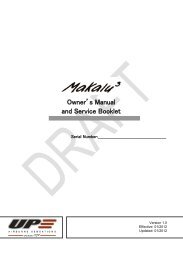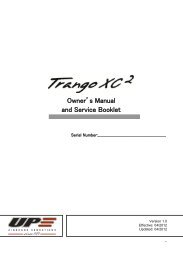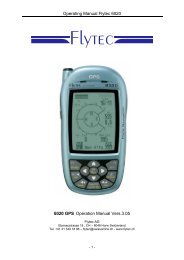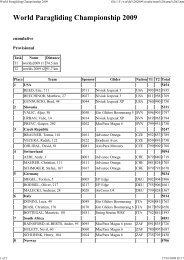Owners Manual and Service booklet - Eagle Paragliding
Owners Manual and Service booklet - Eagle Paragliding
Owners Manual and Service booklet - Eagle Paragliding
- No tags were found...
You also want an ePaper? Increase the reach of your titles
YUMPU automatically turns print PDFs into web optimized ePapers that Google loves.
______________________________________________________________________________Before releasing the brakes <strong>and</strong> allowingthe wing to resume level flight it isimportant to stabilize the stalled wing. Thisis done by releasing the brakes slowlyuntil the entire wing is almost completelyre-inflated. In this phase the wing will bepitching somewhat over the cross axis.The pilot waits until the wing is in front ofhim <strong>and</strong> releases the remaining part of thebrake travel. When timed correctly thewing will then resume level flight bysurging slightly forward whilst acceleratingto normal trim speed. However you mustbe prepared to dampen the surge <strong>and</strong>deal with any subsequent collapsesoccurring because the wing surges too faror doesn’t come out of the full stallcompletely symmetrically.Test pilots also carry out tests where theyrelease one brake before the other whilein full stall. This manoeuvre only serves totest the wings behaviour <strong>and</strong> should notbe flown purposely as this is a situationwhere all paragliders react verydynamically. It is often followed by verylarge, dynamic asymmetric collapses thatmust be dealt with correctly to avoiddangerous situations.SpinThe negative spin occurs when one sideof the wing is stalled whilst the other is stillflying. This can happen when, if flying veryslowly, one brake is pulled quickly tobelow the seat. When the glider starts tospin, it will turn quickly around the verticalaxis, with the stalled side flyingbackwards. To recover from a spin, simplyrelease the brake on the stalled side. Theglider will immediately speed up <strong>and</strong>, mostlikely, suffer an asymmetric collapse.Recover as described above.If you suspect that a spin is imminent thenimmediately release the inside brake. Theglider will accelerate smoothly <strong>and</strong> resumenormal flight with little altitude loss.WingoversWingovers are induced by flyingalternating turns; each time letting thependulum effect increase the bankangle.BEWARE! The UP Ascent 2 isan agile glider, <strong>and</strong> it is quiteeasy to get to anexcessively high angle ofbank in just a few turns.Practice wingovers gently at first,as there is a chance of quite largecollapses at high bank angles.Also notice that a wingover flown withmore than 90 degrees bank angle isclassified as illegal aerobatics in somecountries!Emergency SteeringIf for some reason the UP Ascent 2cannot be controlled with the brakes,for example if the brake h<strong>and</strong>le hascome off the main brake line, it can besteered <strong>and</strong> l<strong>and</strong>ed with the rearrisers. Be aware that, when rear risersteering, the glider is a great dealmore responsive to pilot input, <strong>and</strong> thestall happens very suddenly.Further referencesRain-induced deep stallThere are two reasons why flying witha wet wing increases the risk of deepstalling:First reason is that the canopy clothmay absorb water, making it muchheavier <strong>and</strong> moving the centre ofgravity around in unpredictable ways,increasing the risk of a stall/deep stall.The more water a wing can absorb thehigher the risk, which means that older32






